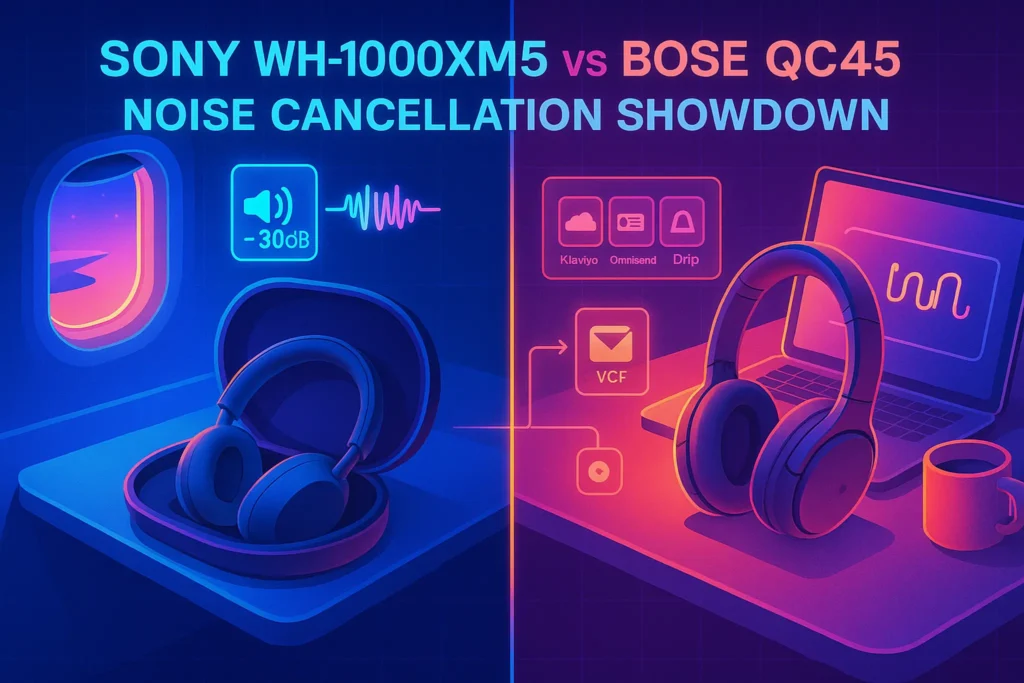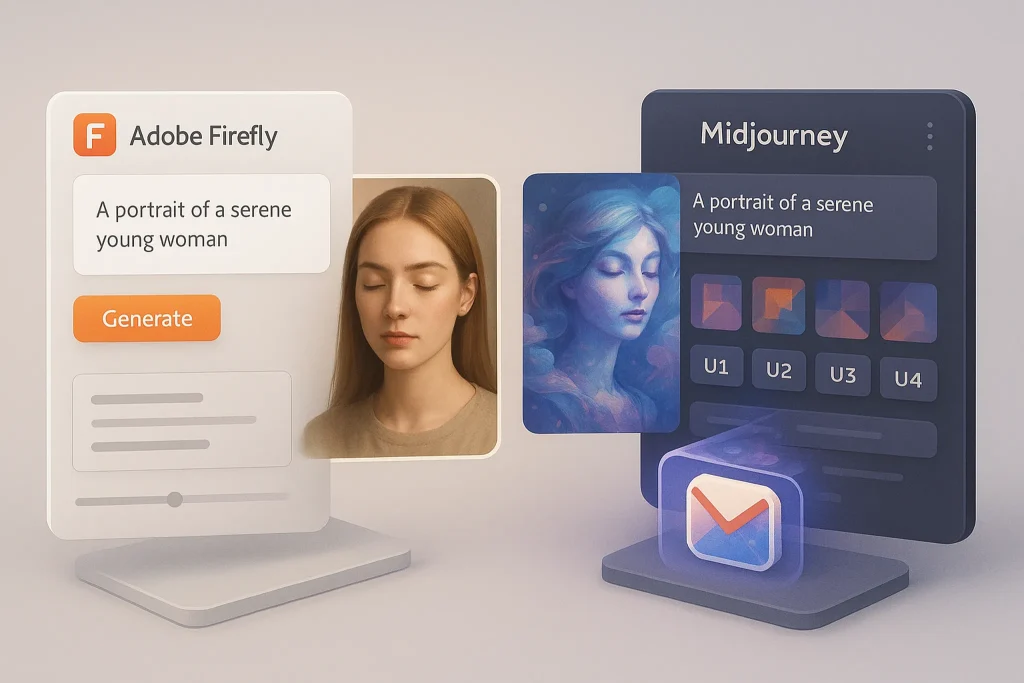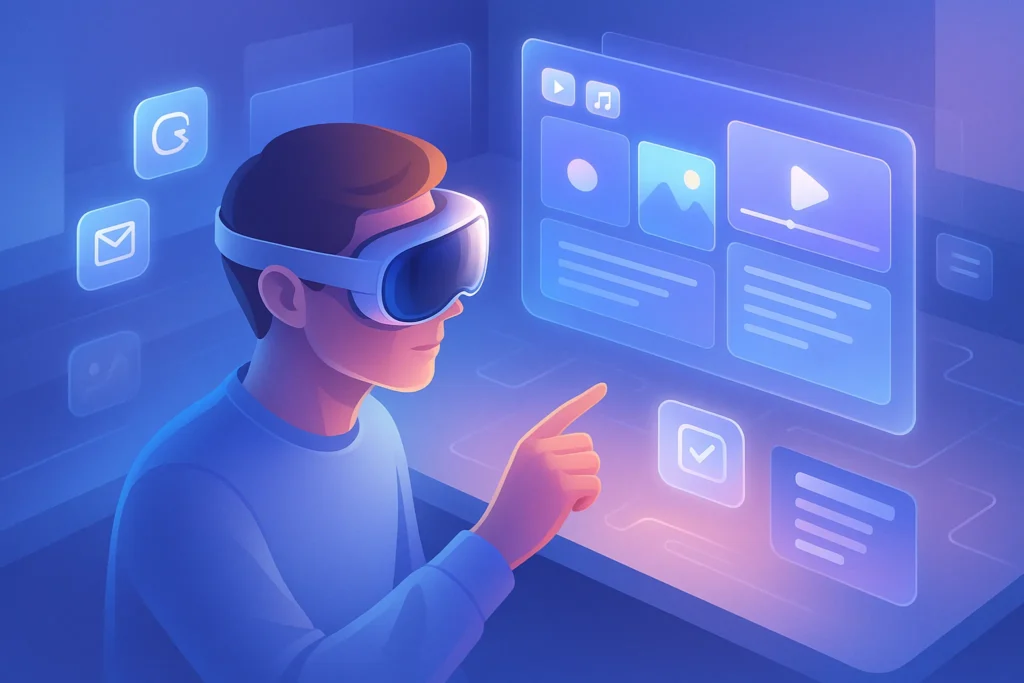Intro:
If you’re shopping for premium noise-cancelling headphones in 2025, two names keep popping up: Sony WH-1000XM5 and Bose QC45. Sony’s the tech-forward contender with adaptive ANC and deep app control; Bose is the legacy champ of “put them on and the world vanishes.” On paper, both promise quiet commutes and calmer workdays. In practice, they behave differently depending on where you listen and what you care about (music, calls, marathon comfort, or pure silence).
This deep dive compares them head-to-head across noise cancellation, sound quality, calls, comfort/design, battery/charging, apps/connectivity, and price/value. I’ll anchor the findings in real situations—airplane cabin, subway commute, open office, street café, and home AC/hum—so you know how they cope with steady hums vs chattery voices vs wind gusts. If you end up thinking “great, but I need something cheaper,” park this tab and skim our guide to Best Budget Noise-Cancelling Headphones Under $150 for surprisingly strong mid-tier picks.
don’t just ask “which is better?” Ask “which is better for my noise and my use case.
🧪 Test Protocol (so the results are trustworthy)
Before the verdicts, a quick word on how I tested:
-
Environments: turbo-fan recordings for plane noise, a white-noise generator and HVAC for steady low-end hum, recorded office chatter for midrange voices, and an outdoor pink-noise bed for wind checks.
-
Fit/Seal: both models adjusted to similar clamp force; new earpads; glasses worn for part of testing to see if seal breaks.
-
Settings: default ANC first, then app-tuned presets (Sony’s adaptive profiles; Bose’s Quiet/Aware with EQ). Multipoint on for a portion to simulate real life.
-
Sources: Apple Music lossless (wired DAC test too), Netflix/Prime for video latency checks, phone/laptop calls, and a few noisy coffee shop calls.
This is about lived performance more than spec sheets. Your ears, head shape, and environment may differ—but the patterns below are consistent across days and devices.
🎧 Noise Cancellation (Head-to-Head in Real Environments)
Airplane cabin (steady low-frequency roar).
This is where ANC reputations are earned. Sony WH-1000XM5 pulls slightly ahead on sub-bass rumble. The cabin roar sinks a bit deeper on XM5, and pressure sensation is mild once your ears acclimate. Bose QC45 still does great work here—Bose’s “blanket of quiet” remains convincing—but the last few dB of low-end attenuation feel stronger on the Sony. If your priority is long-haul flights, the XM5 has the edge.
Open office (HVAC + keyboard clack + voices).
For steady vents and mechanical hum, it’s close—both mute the backdrop well. On voices, Bose’s tuning softens the midrange chatter in a way that feels natural and not “ear-sucking.” Sony reduces voices too, but occasionally lets sibilants poke through unless you’re using the Adaptive Sound Control with an aggressive profile. If your office pain is human speech, QC45’s voicing can be subjectively nicer for long stretches.
Subway/commute (rumble + screech + announcements).
Sony’s algorithm proves adaptable when the soundscape shifts—train clatter, station reverb, platform wind. The XM5 recovers quickly after sudden spikes (door slams, braking). Bose is a touch calmer with constant rumble, but sudden high-mid shrieks sometimes feel less suppressed than on Sony. Edge to Sony for chaotic urban noise; tie on simple rumble.
Street café (crowd babble, music bleed, scooters).
Voice masking is again the decider. With café chatter, Bose filters the midband pleasantly, avoiding the “hollow” feel some ANC can create. Sony does well; paired with ambient control it’s easy to dial in how much of the world leaks in between tracks. If you frequently work in cafés and want voices dulled but not surgically erased, the QC45 can feel more neutral.
Wind handling.
Direct wind is the Achilles’ heel of many ANC systems. Both can exhibit whoosh if a gust hits the mic ports. The XM5’s wind reduction setting helps; wearing a hood or angling cups cuts artifacts further. The QC45 sometimes resonates earlier with cross-breezes but stays stable in moderate wind. If you run outdoors, neither is ideal; in that case consider sport-leaning buds or plan to toggle ambient quickly.
Bottom line for ANC:
-
Airplane / chaotic transit: Sony WH-1000XM5
-
Office voices / calm work: Bose QC45
-
Everywhere else: it’s close enough that fit/seal and your specific noise matter more than lab deltas.
If you’re building a quiet, distraction-free desk to pair with either, our Logitech MX Mechanical Keyboard Review explains why low-travel switches and damped frames can reduce the “clack backdrop” further—and Portable Monitors and Other Underrated Productivity Gadgets has a few stealth upgrades that pair nicely with ANC days.
🎶 Sound Quality (Music, Movies, and the “Daily Mix” Reality)
Tonal balance.
Straight out of the box, Sony XM5 leans toward a modern, slightly warm tilt with confident bass reach and a clean, slightly forward upper-mid that makes vocals pop. Bose QC45 aims for a smoother, easy-listening curve: bass is present but polite, mids are relaxed, treble is safe. If you like energy and sub-bass authority, Sony feels livelier; if you want non-fatiguing long sessions, Bose’s gentler mid/treble can win.
Detail & separation.
On acoustic and well-recorded pop, Sony resolves micro-details (pluck, breath, room cues) a bit better, helped by the XM5’s driver tuning and processing. Layered mixes hold separation during choruses without smearing. Bose remains musical and pleasant, but complex passages can feel blended sooner.
EQ headroom.
Sony Headphones Connect offers parametric-style bands and saved presets, so you can dial bass shelf or brighten 3–5 kHz without crashing into distortion. Bose Music app now includes EQ that’s simpler but effective for quick tweaks. If you love tweaking, Sony’s sandbox is bigger; if you just want “a little more bass,” both apps oblige.
Movies & latency.
Both handle streaming lipsync fine on modern phones/laptops. Sony can pair better with certain codecs and adaptive bitrates, but in practical use I didn’t find one breaking immersion where the other didn’t. Wired playback (airline adapter + 3.5 mm) is possible on both, though ANC behavior differs slightly when cabled.
Calls and mic quality.
In quiet rooms, both transmit clean speech. In noisy environments, Sony XM5 applies more aggressive noise reduction—your voice cuts through better on a subway platform, albeit with occasional processing artifacts. Bose QC45 keeps voices natural but can let more background bleed. For tough call conditions, Sony gets the nod.
Daily mixes & long sessions.
If your soundtrack goes from EDM to podcasts to jazz in an afternoon, Sony’s dynamics keep things exciting; for eight-hour playlists while writing or coding, Bose’s rest-easy tonality reduces fatigue. Pair either with Smart Home Gadgets that automate do-not-disturb scenes and you’ve got a focus cocoon.
🛋️ Comfort & Design (Workdays and Red-Eye Flights)
Weight & clamp.
Both are comfortably light. Bose QC45 has the classic QuietComfort recipe: soft clamp, pillowy pads, and a headband that disappears after an hour. Sony XM5 uses a sleeker yoke with thicker pads than XM4; clamp is a touch firmer out of the box but distributes well. Over multi-hour sessions, Bose stays almost invisible; Sony is very comfortable but a hair more present on the jawline for some heads.
Heat & pads.
Neither is sweaty by design, but memory foam means heat build-up after a few hours is normal. QC45’s pads breathe slightly better in my experience. If you wear glasses, both seals break a little; Sony’s thicker pads help recover ANC with gentle repositioning.
Portability & case.
The QC45 folds flat and inward, making it more compact in a backpack. XM5’s case is improved but still occupies more volume because the cups don’t fold the same way. If you travel ultralight, Bose packs smaller.
Controls & usability.
Sony blends touch gestures (swipes for volume/skip) with physical power/pairing. Bose leans a bit more on physical buttons for ANC/Aware and playback—great with gloves and in the dark. For pure muscle memory, Bose is simpler; for modern gesture fans, Sony’s panel is handy. Quick-attention features (Sony’s palm-over-cup and Speak-to-Chat) are truly useful during flights and office interruptions.
Comfort verdict:
-
All-day desk / long flights / glasses: slight edge to Bose QC45 for the ultra-forgiving fit.
-
Everyday commuting / modern features: Sony XM5 is still very comfortable and wins on “smart” conveniences.
If your comfort stack includes long keyboard sessions and portable displays, a minimal travel rig plus ANC can feel like a productivity cheat—see Portable Monitors and Other Underrated Productivity Gadgets for options that pair nicely on trains and in cafés.
🔋 Battery Life & Charging Speed
Battery life.
Both land in the full-workweek zone with ANC on. Sony XM5 is rated around the 30-hour mark; Bose QC45 slightly lower on paper (historically ~24 hours), but in mixed use the gap narrows if you play at lower volumes. In real life, either can handle a round trip with layovers plus a couple of office days before anxiety kicks in.
Quick charge.
Both support fast top-ups that turn “oh no” moments into “I’m fine.” Sony is notably efficient: a brief plug gets you multiple hours of playback; Bose’s 15-minute splash typically nets a few hours too. If you’re a chronic last-minute charger, Sony’s faster burst refuels are reassuring.
Ports & cables.
Both use USB-C for charging and support wired playback via 3.5 mm (with caveats around power state and ANC behavior). Keep a short C-to-C in your travel pouch; it solves 80% of trip stress.
📱 App Features & Connectivity (EQ, Ambient, Multipoint)
EQ and sound controls.
Sony’s Headphones Connect app is a playground: multi-band EQ, 360 Reality Audio setup, Adaptive Sound Control that shifts ANC/ambient by location/activity, and clever features like Speak-to-Chat (auto-pauses when you talk). Bose’s Music app is simpler: a solid EQ, Quiet/Aware ANC modes, and self-voice/side-tone for calls. If you love tuning and automations, Sony has more to explore; if you want set-and-forget, Bose is refreshingly direct.
ANC/ambient granularity.
XM5 lets you dial ambient in fine steps and set automation per context (office vs commute). QC45 prefers “two modes, one toggle,” which many users appreciate for predictability. Both support aware/transparency to hear announcements or quick chats.
Multipoint and stability.
Both support multipoint so you can hop from laptop meetings to phone calls seamlessly. Sony’s handover is quick; Bose is stable and straightforward. If you live in a Bluetooth-dense office, either may hiccup occasionally; keeping firmware updated via the app helps.
Voice assistants & extras.
Both play nicely with Siri/Google Assistant, and both remember multiple devices. Sony’s extras skew toward automation and context; Bose’s extras skew toward clarity and controls you won’t accidentally trigger.
💰 Price & Value in 2025
MSRPs put Sony WH-1000XM5 traditionally higher than Bose QC45, but street prices fluctuate throughout the year—sale seasons, bundles, and colorways can move the gap. In 2025, it’s common to see the XM5 dip during major promos, while the QC45—being older—often sits at attractive everyday pricing. If you need the absolute best ANC + features and enjoy app tuning, Sony is worth the premium. If you want comfort first and “it just works” simplicity at a lower cost, Bose offers tremendous value.
If neither price feels right, take a peek at Best Budget Noise-Cancelling Headphones Under $150—they won’t beat these flagships, but they’re shockingly capable for commutes and open offices.
🎨 Mini-Comparisons
Noise cancellation in one sentence:
-
Sony WH-1000XM5: deeper low-end suppression and better handling of chaotic, shifting noise.
-
Bose QC45: wonderfully calm with office voices and long, steady hums.
Sound signature in one sentence:
-
Sony: lively, modern, detail-forward with authoritative sub-bass (tweakable).
-
Bose: relaxed, fatigue-free, musical, with safer treble.
Comfort in one sentence:
-
Sony: very comfortable; slightly firmer clamp; ultra-handy smart features.
-
Bose: forget-you-wear-them comfort; packs smaller; physical buttons.
Calls in one sentence:
-
Sony: stronger noise rejection in chaos, sometimes more processing.
-
Bose: natural voice tone, slightly more background bleed.
🧠 Who Should Buy Which?
Choose Sony WH-1000XM5 if you:
-
Travel frequently and want the strongest low-frequency ANC for planes and trains.
-
Like tuning (EQ, ambient levels) and appreciate smart tricks like Speak-to-Chat and Adaptive Sound.
-
Make calls in chaotic environments and need your voice to punch through noise.
Choose Bose QC45 if you:
-
Wear headphones for six-hour blocks and crave effortless comfort with simple controls.
-
Spend most time in offices/cafés where voice masking and steady hum suppression are the priority.
-
Prefer a smaller travel footprint and predictable “one-toggle” ANC behavior.
If you’re assembling a wellness-meets-focus kit for long workweeks, pairing either with the routines we discuss in Oura Ring Gen 3 Review After 6 Months can help you spot when to rest vs push—ANC is only half the focus story.
🧠 Smart Pick
If you’re ready to pull the trigger, start with your primary environment:
-
Fly often or ride subways daily? Go Sony WH-1000XM5 for deeper rumble control and feature depth.
-
Sit in meetings for hours or work in shared spaces? Go Bose QC45 for all-day comfort and natural voice masking.
📬 Want the ANC Tuning Cheat Sheet for XM5 & QC45?
Get a print-ready preset pack for flights, open offices, and cafés—plus quick fixes for wind whoosh, call clarity tips, and EQ templates for both apps.
Includes: Flight Deep-Quiet, Office Voice-Mask, Café Transparency Balance, mic tweaks for Zoom/Meet, and a 60-second troubleshooting flow.
🔐 100% privacy. No spam. Just practical audio presets and updates from NerdChips.
🧠 Nerd Verdict
Silence isn’t one thing; it’s a mix of rumbles, voices, and gusts. Sony WH-1000XM5 is the better noise-eraser in chaotic, low-frequency environments and the tinkerer’s dream with its app features. Bose QC45 is the better wear-all-day companion with natural voice softening and travel-friendly design. Pick based on your noise, not your FOMO.
❓ FAQ: Nerds Ask, We Answer
💬 Would You Bite?
Where will you wear your headphones most—planes, offices, or streets?
Tell me your main environment and one pain noise, and I’ll suggest the best model plus an app preset to start with. 👇



